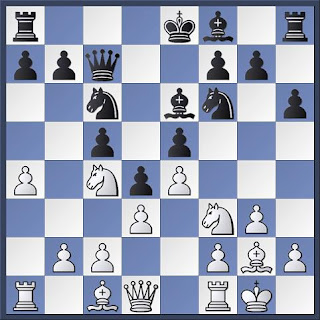My game with 'E' was interesting, because he played the opening quite well. The middle game was non existant, as a general exchange of pieces in the center, ending with the exchange of queens on c6 placed us in a normal Pirc engame. Lots of Pirc lines lead to these kind of positions:
| White to move |
Black has a central pawn mass, but three pawn islands. Black needs to restrain the activity of white's pieces and get those central pawns moving, before white can pick off the isolated rook pawns.
Here he made an inaccurate move: 1. b4? He wanted to preserve his Nc6, but I don't think he can, and wanted to get his queenside pawn majority rolling to make a passed pawn. I was gong to try to prevent his knight from having a central outpost, and push my center pawn mass, but his move allowed me to make the pawn at c3 backward. I played 1...d5 to do this, but this was not the best move, because it weakened the dark squares in the center, Nb6 would have been better and make it easier to prevent his knight finding a secure post. His next move 2.f4 reinforced the dark square weakness, but allowed me the opportunity to create a second weakness. I added to my plan creating an artificially isolated pawn out of the one on f4 or a backward pawn on g3. The next few moves were about securing the c3 pawn as permanently backward. 2...Nb6 3.Rc1 a6 3.Ke2 Rc8 4.Nd4 Kd7 5.Kd3 for a while, the outpost on d4 will be secure for white's knight.
Here he made an inaccurate move: 1. b4? He wanted to preserve his Nc6, but I don't think he can, and wanted to get his queenside pawn majority rolling to make a passed pawn. I was gong to try to prevent his knight from having a central outpost, and push my center pawn mass, but his move allowed me to make the pawn at c3 backward. I played 1...d5 to do this, but this was not the best move, because it weakened the dark squares in the center, Nb6 would have been better and make it easier to prevent his knight finding a secure post. His next move 2.f4 reinforced the dark square weakness, but allowed me the opportunity to create a second weakness. I added to my plan creating an artificially isolated pawn out of the one on f4 or a backward pawn on g3. The next few moves were about securing the c3 pawn as permanently backward. 2...Nb6 3.Rc1 a6 3.Ke2 Rc8 4.Nd4 Kd7 5.Kd3 for a while, the outpost on d4 will be secure for white's knight.
| Black to move |
| White to move |
8.Ne5+ Ke7 9.Rb1 White does not have any good moves here, but Nxc4 would have been better. Long term, I will remove all outposts for this knight, while mine will be very well posted on e4. 9...Nd6 10.a4 Rhg8 11. Re2 f6 The Ne5 must vacate 12.Nf3 Rg4 13.Nd4 Ne4 My knight has reached its outpost on e4 and white is further constrained. There is no hurry to take the pawn on f4 it is not going anywhere 14.Rc2 Rxf4 15.Ne2? Rf2 16.Rg1
| Black to move |
White was running short on time, so I tried the trappy 16...h3, which is a good move, but not quite as good as the slow but sure 16...e5. After 16...h3, white cannot defend both c3 and g2. The g2 pawn cannot move, because both 17.g3 and 17.gxh3 Rf3+ 18.Kd4 Rc4#
diagrams for this post made from Apronus Chess







